How Do I Make Raised Garden Beds To Keep Voles Out
No matter how cute they may be, chipmunks can cause serious damage when they run amok in your yard and garden. They can build extensive burrows under your flower beds and grass, potentially damaging structure and walkways.
They'll eat your plants, steal your vegetables, and even dig up plants to get at the bulbs — tossing out young plants as trash.
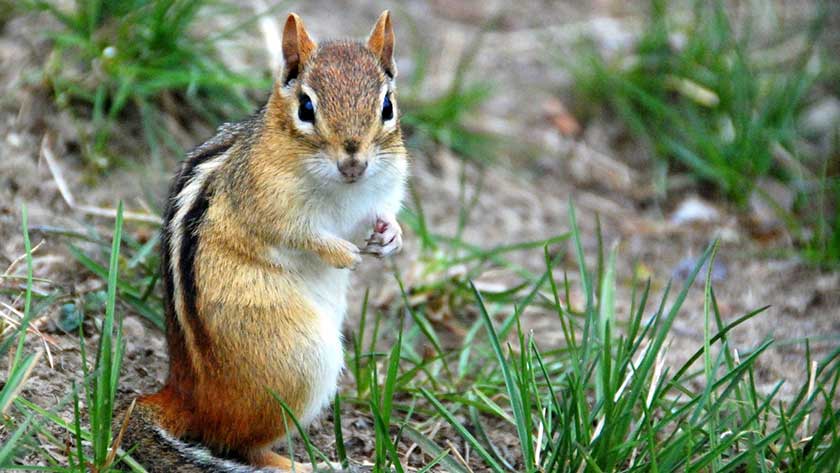
Want to know how to get rid of chipmunks? Start by reducing their food supply like birdseed and remove as much continuous cover as you can. You can use a combination of non-lethal and lethal traps like electronic traps to catch them as they come out of the burrow before sealing them.
Chipmunks are notoriously difficult to get rid of. You will probably always have some amount of chipmunks around your home unless you make it completely inhospitable and uninteresting to them which means no plants and wide, open space with no cover.
Still, getting rid of chipmunks that have become a problem is possible to prevent damage to your lawn and garden. Here's how to get rid of chipmunks and enjoy a property free of holes and burrows.
Here's everything you need to know about getting rid of chipmunks before they cause more extensive damage to your beautiful landscaping.
Quick Navigation: What's in This Guide?
- Here are the Best Ways to Get Rid of Chipmunks
- 1. Move Bird Feeders
- 2. Chipmunk-Proof Bird Feeders
- 3. Live Trap Chipmunks
- 4. Protect Bulbs from Chipmunks
- 5. Use an Electronic Rodent Trap
- 6. Reduce Cover for Chipmunks
- 7. Spray Plants with a Natural Chipmunk Repellent
- 8. Set up a Chipmunk Trap Bucket
- 9. Gas Chipmunks Out of Hiding
- 10. Seal Areas Under the Deck, Porch, and Shed
Here are the Best Ways to Get Rid of Chipmunks
1. Move Bird Feeders
Want chipmunks around your house? Set up a bird feeder stocked with their favorite food: seeds and nuts. A very simple but effective way to prevent chipmunks from around the yard is getting rid of the bird feeders or simply moving them. It's a good idea to move the bird feeders at least 15 feet away from your house and garden. You can also sweep around the bird feeder now and then if it's located next to pavement or pavers.
The chipmunks will be attracted to the spilled birdseed that hits the ground but at least they won't be close enough to investigate your garden.
2. Chipmunk-Proof Bird Feeders
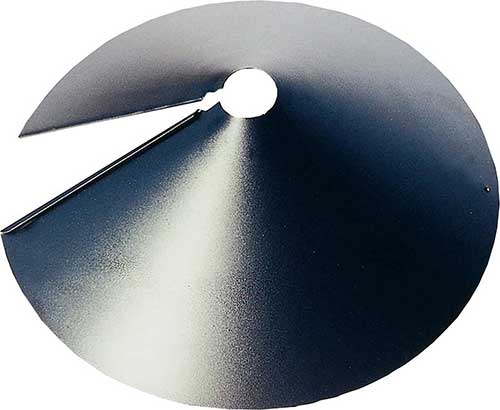
Buy from Amazon
Moving your bird feeders is a great idea if they're too close to the house but you should also invest in chipmunk- and squirrel-proofing your bird feeders. There are plenty of ways to do this.
Make sure you hang bird feeders from a free-standing, smooth pole far from anything the chipmunks can climb and use to jump to the feeder. Don't hang bird feeders from a tree unless you're willing to go to great lengths to protect it.
Next, use a wrap-around bird feeder baffle that prevents chipmunks from climbing the pole and accessing the bird feeder.
Place the baffle 5 feet above the ground to prevent chipmunks from jumping over it.
Don't bother replacing sunflower seeds in your feeder with safflower seeds in an attempt to deter chipmunks. While it's true squirrels won't eat safflower seeds because they taste bitter, chipmunks like them just fine.
You can also skip the hot pepper products. These work against squirrels and raccoons who are after birdseed but don't affect birds at all. Chipmunks are a different story. Their fur-lined pouched cheeks seem to create a barrier that prevents the hot pepper from burning.
Related Article: 12 Best Squirrel Proof Bird Feeders
3. Live Trap Chipmunks
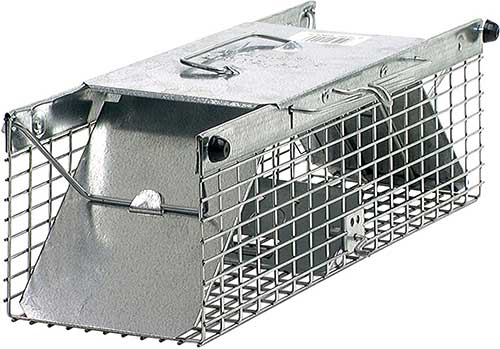
Buy from Amazon
There are definitely concerns with using live traps for chipmunks which are explained in greater detail below. If you decide you want to live trap chipmunks to get them out from under a shed or deck — or to relocate them off your property completely — just make sure you do it the right way.
Use a humane live trap for chipmunks with doors that close via a spring on a baited platform. The best bait to use for chipmunks? Peanut butter or sunflower seeds.
When the chipmunk steps on the platform inside the trap to take the bait, the spring will activate to close the doors. You can then relocate the chipmunk and set it free unharmed.
Trapping won't deter chipmunks from bothering your garden or digging in your lawn. They're only effective for removing the chipmunks you have now.
Catch and Release Chipmunks
Before trapping and releasing chipmunks, make sure you check if it's legal to catch and relocate wildlife in your state and county. In some areas, it's perfectly legal to trap and release chipmunks away from your property as long as you are allowed to release them in the new area. Some states have laws stating that wildlife cannot be relocated from your property. In these cases, you can remove the chipmunks from one area but they must be released on another area of your property.
If you set live traps on your property, make sure you check them often. Relocate the chipmunk as soon as you can once it's trapped. To make sure the chipmunk can't return to your property, you'll need to relocate it at least five miles from your property, if legal.
After the chipmunk is trapped, you can cover the cage with a blanket to help the chipmunk calm down and prevent it from reaching through openings. When handling the trap, you should be able to open the door without getting too close to the cage. To release the chipmunk, set the trap on level ground and pull the blanket back from the door. Stand behind the cage and make sure the door is facing shrubs or an area with good cover that the chipmunk will want to run to. Reach over the cage to open the door then step back as the chipmunk flees.
Related Article: 17 Best Ways to Get Rid of Rats
4. Protect Bulbs from Chipmunks
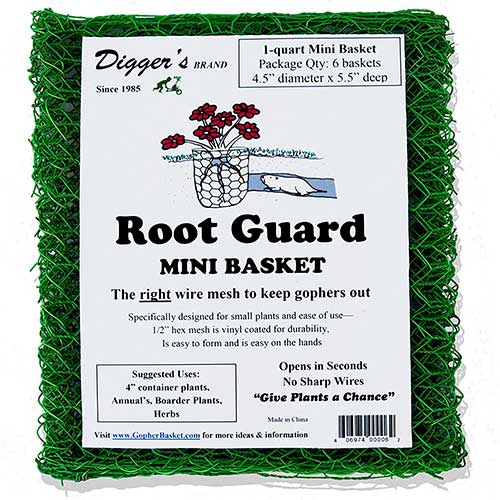
Buy from Amazon
Even if you don't have a chipmunk problem, there's nothing stopping a chipmunk from the neighbor's yard from checking out your flower bed for a meal. To protect flower bulbs, plant the bulbs under a screen ground cover or use bulb baskets.
Because these solutions can get expensive if used for every planting, you may want to reserve them for new or valued bulbs in the garden and be sure to use other methods to keep chipmunks out of the garden.
Related Article: 7 Best Ways to Get Rid of Moles
5. Use an Electronic Rodent Trap
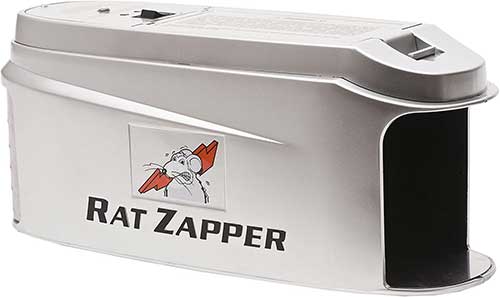
Buy from Amazon
This electronic chipmunk trap comes in a bundle pack of 4, 2, or individually. Electronic rodent traps are great for getting rid of problematic rodents inside and outside of your home, but keep in mind they won't stop more chipmunks from showing up or act as a deterrent.
Still, you can use electronic traps to clear out a chipmunk burrow as they emerge to forage for food or catch them in the garden.
The Rat Zapper Ultra is a good choice for killing problematic chipmunks around the home. While designed for rats, it's large enough with a high enough voltage to kill chipmunks as humanely as possible.
An electronic chipmunk trap works by delivering a fatal high-voltage shock that kills the chipmunk very quickly. These traps are safe to use around your home with a tamper-proof design that won't hurt your pets and a small enough opening that larger wildlife around your property will be unharmed.
Once a chipmunk steps on the metal plates in the trap, a circuit will be completed and a continuous high-voltage shock will be delivered for 2 full minutes to ensure the chipmunk is killed.
Proper Use of Electronic Rodent Trap
When used properly, electronic rodent traps have a 100% kill rate. To use the trap correctly, make sure you follow these guidelines:
- Make sure the trap is set where you see high chipmunk activity such as near the entrance to their burrow or along shrubs close to your flower beds.
- Make sure the trap is on and the batteries are charged.
- Set the trap with bait that will attract chipmunks. This includes peanut butter, shelled sunflower seeds, or breakfast cereal.
- Use gloves when handling the trap to avoid transferring your scent to the electronic device.
- Don't use too much bait. This can make it too easy for the chipmunk to reach into the trap and grab the bait without activating the trap. Too much food can also drop onto the metal plate and activate the trap prematurely, allowing the chipmunk to safely enter and feast.
One of the best things about using electronic traps is they are completely reusable and they can last years, not only against chipmunks but also against other rodent pests such as rats outdoors or mice in your home.
Because you'll be using the Rat Zapper Ultra outdoors, make sure you cover it if you'll leave it out overnight or when it's wet. You can simply cover it with an upside-down plastic container with a large hole cut in the side as a door for the chipmunks. Be sure to place a couple of sunflower seeds near the door you cut so chipmunks easily find the entrance.
Related Article: 10 Best Rat Traps
6. Reduce Cover for Chipmunks
While chipmunks don't need cover to survive, they won't want to stick around an area without cover for safety and hiding. If your property has plenty of ground cover in the form of woodpiles, overgrown plants, and shrubs near the house and garden, you can be sure you'll attract chipmunks.
Get rid of piles of wood from around the house and check carefully for areas that give chipmunks easy places to hide. The biggest problem is long runs of cover such as overgrown plants next to shrubs that grow along the house. This gives the chipmunk an easy way to cover large distances without being seen by predators. Make sure the cover is broken up in many areas, especially from any wooded area to the home or garden.
7. Spray Plants with a Natural Chipmunk Repellent
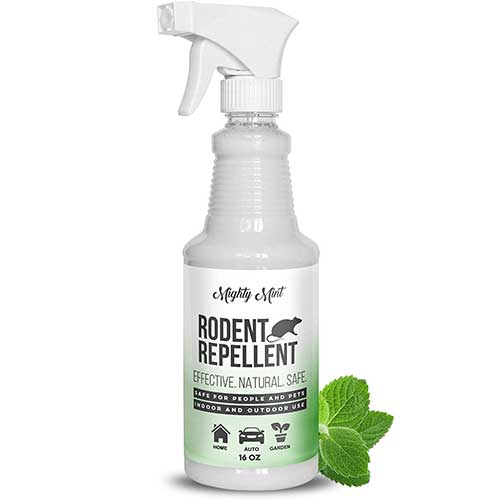
Buy from Amazon
Chipmunks love most plants but not everything. There are certain plants they tend to avoid due to strong fragrances or fuzzy leaves. You don't need to replace the plants in your garden but spraying them with essential oils of plants they don't like can help protect the plants from becoming chipmunk food.
Spraying a chipmunk repellent won't work completely and it definitely won't do much on its own. Still, it's a good non-toxic solution to protect your plants in addition to exclusion methods.
Good choices for making a chipmunk repellent spray include:
- Garlic oil
- Peppermint oil
- Cayenne pepper
- Eucalyptus oil
- Cinnamon oil
- Citrus oil
Add several drops of your chosen oil to a bottle of water and spray on your plants. This can help keep chipmunks from taking a bite. You can also buy a ready-to-use chipmunk repellent like Mighty Mint.
No matter which option you choose, don't expect it to keep chipmunks away on its own or be 100% effective. You'll also need to reapply the spray fairly often and always after it rains.
8. Set up a Chipmunk Trap Bucket
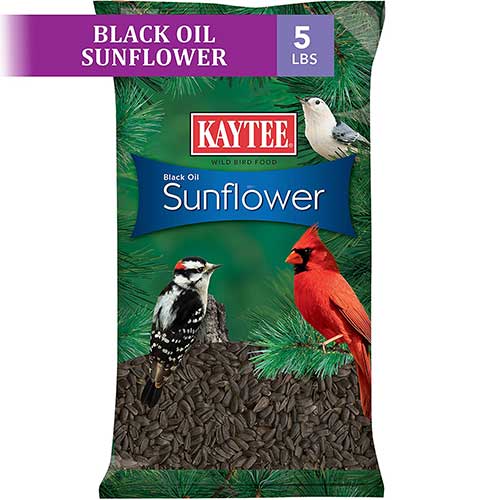
Buy from Amazon
Bothered by a group of chipmunks that won't leave your garden alone? An effective, cheap, and lethal solution is a chipmunk trap bucket that you can build yourself. Before deciding this is the right solution for you, keep in mind it works by drowning the chipmunks. This isn't a humane method as the chipmunks will swim as long as they can before drowning and this can take a long time.
You'll only need a few supplies to build a trap bucket:
- A 5-gallon bucket
- Large bag of black oil sunflower seeds
- 4-foot 1×3 wood
Place the bucket on a flat area of ground near where the chipmunks are causing damage or congregate. Fill the bucket 2/3 full with water then add enough seeds to completely cover the surface. The seeds to float on top of the water to disguise the danger.
Use the 1×3 wood to create a long, gentle ramp to the top of the bucket. Let the wood overhang the bucket by just a few inches. If necessary, add a nail to the end of the wood to create a hook that stops it from slipping off the bucket.
The trap will last for a few days before the sunflower seeds get too soggy and stink or no longer smell fresh enough to entice chipmunks into the bucket. When the seeds get too old, just scoop them out and add fresh seeds or start with new water and seeds.
The trap is effective because it attracts small rodents specifically. Larger animals can typically just grab the seeds from the surface without falling in.
9. Gas Chipmunks Out of Hiding
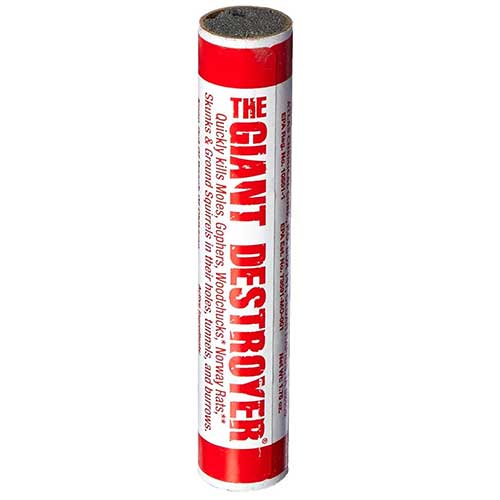
Buy from Amazon
Do you have a problem with chipmunks burrowing in your garden and lawn? An effective solution to quickly evict them from the burrow and potentially kill them is the Giant Destroyer gas cartridges from Atlas.
These tubes are lit and applied to the entrance of a burrow which is then covered. Toxic smoke fills the tunnels and drives away the chipmunks or kills them if they can't get out through another opening in time.
Gas canisters won't necessarily kill an entire family of chipmunks but it will definitely evict them so you can fill in the holes and set up exclusion methods to keep them from returning.
Toxic Fumes in Gas Cartridges
If you decide to use Atlas Giant Destroyer cartridges, just take care. Use the following guidelines to stay safe and protect yourself from the toxic fumes.
- Practice putting the cartridge into the hole a few times before you actually light the fuse and get ready to use it. Make sure the opening is large enough to quickly place the tube.
- Hold the cartridge with BBQ tongs and keep it as far away from you as possible. This allows you to place the cartridge into the chipmunk hole from a greater distance.
- Have something on hand to cover the hole immediately after you place the cartridge. You will have just a few seconds to do this. You can use a large bucket filled with rocks or dirt to cover the hole.
- Hold your breath once the fuse is lit and until the hole is covered.
- Wait several hours before lifting the cover of the hole.
If possible, make sure the chipmunks are actually in the hole before using the cartridge. Chipmunks are most active during the day. You can watch for them entering the hole or use the Giant Destroyer tubes at dusk.
10. Seal Areas Under the Deck, Porch, and Shed
Chipmunks love having cover as they scurry around. Dark, secluded areas under the deck and shed can be a perfect place to starting their burrow where they can quickly and safely multiply.
After kicking chipmunks out of the area with the gas cartridges or live traps, it's time to seal these areas away from pests. After all, it's not just chipmunks these dark, secluded spaces attract.
10-gauge galvanized steel mesh is a good choice for sealing open areas. To protect against burrowing or digging pests like chipmunks, make sure the mesh is at least 6 inches below the ground and covered back with dirt. You can mount the galvanized metal mesh to the wood frame of your shed or deck to keep larger animals from tearing it off.
Chipmunk Damage and Why They're a Problem
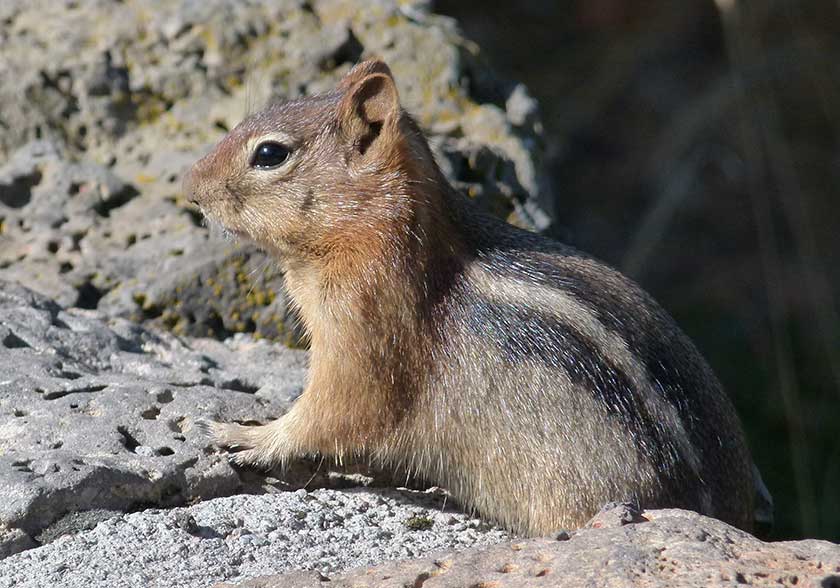
When you see a chipmunk exploring your yard, you may think of Chip and Dale or Alvin and the Chipmunks. Chipmunks are definitely cute with their tiny faces and fuzzy tails, but they also have the potential to cause extensive damage to your garden, lawn, and even your home.
A member of the squirrel family, chipmunks are about 5 inches long with a 3″ tail and they're known for their burrowing habits. Chipmunks love areas with lots of ground cover like shrubbery, trees, logs, and brush and they'll make their home anywhere with enough cover, including fence lines, hedges, your flower beds, or around your home.
The most obvious problem with chipmunks is the physical damage they can leave behind.
Chipmunks create extensive burrow systems underground. They'll make shallow burrows to use as cover while they forage and deep, extensive burrows for nesting, storing food, and spending the winter.
These burrows can cause damage to your home's foundation and structure. When a chipmunk burrows under a paver walkway, the pavers may start to collapse. Their burrowing can also damage retention walls, stairs, and patios. They can leave unsightly holes in your garden and lawn, uproot bulbs, and destroy your vegetable garden.
The good news is it's unlikely for chipmunks to cause serious structural problems around your home and shed. Their greatest threat is to your yard and garden, especially if you value your prized flowers and pristine yard.
Chipmunks Can Carry Disease
Chipmunks can also carry diseases that can spread to humans. squirrels and chipmunks in the United States can carry and spread hantavirus, salmonella, tularemia, and plague.
Plague is a once-common bacterial infection infamously killed 30-50% of the population of Europe. Y. pestis, the plague bacteria, isn't actually carried by the chipmunks but what's on the chipmunks: infected fleas.
Hantavirus is a rare but life-threatening respiratory virus that can be spread by rats, mice, chipmunks, and other rodents. According to one study of hantavirus in national parks in the central and eastern U.S., 1 in 33 chipmunks had hantavirus.
Salmonella is another concern with chipmunks. You may catch salmonella if you consume food contaminated with chipmunk feces. Admittedly, this isn't a huge concern with outdoor pests.
Tularemia is a bacterial disease that can be spread by chipmunks as well as squirrels, rabbits, mice, prairie dogs, and more. This disease is concerning because 30-60% of people who acquire tularemia die.
Identifying a Chipmunk Problem
Not sure if you actually have a chipmunk problem? You may see chipmunks exploring your yard but that doesn't necessarily mean they live very close. Chipmunks will travel up to 1/3 mile from their burrow in search of food.
Chipmunk damage and burrows are usually easy to recognize, however. Look for these signs of chipmunk damage around the lawn:
- Chipmunk holes in yard or garden. Chipmunk holes are about 2″ in diameter with no dirt or debris around the opening.
- Piles of seeds beneath bird feeders
- Uprooted plant bulbs in the flower bed
- Chipmunk tracks in mud or dirt. These tiny prints have four toes in front and five toes in the back but you'll see the hind and front feet reversed. The larger footprints with five toes will be in the front.
How to Get Rid of Chipmunks in Walls
Unlike mice, chipmunks don't really want to live in your home. Chipmunks rarely enter a home and when they do, it's usually by accident and they may enter a crawl space or basement. Still, it isn't unheard of for chipmunks to get into the attic or the walls of a home where they can damage electrical wiring and become a nuisance.
To get rid of chipmunks in walls, identify how they entered the wall void. You may have openings along your foundation or into the attic when allowed the animals to enter. You can set live traps or choose a lethal trap option at the openings like the Rat Zapper Ultra (you can buy traps individually for around $50) baited with something that attracts chipmunks like seeds or peanut butter. Once the chipmunk is removed, make sure the opening is sealed.
How to Fill Chipmunk Holes
Now that you know how to get rid of chipmunks, it's time to tackle the holes they've left in your yard and garden. Don't bother trying to fill chipmunk holes with sand, gravel, or concrete until you've banished the chipmunks from the burrow. Otherwise, they will quickly and easily dig new entrances to their burrow, even if they were trapped underground.
The easiest way to fill chipmunk holes is with clean sand topped with dirt. If the hole is somewhere you will never need to plant anything, you can use a concrete mix to fill the hole and tunnels below but this isn't the best idea. You may be creating an extensive network of concrete under the ground that you'll regret when you need to dig in the area.
Chipmunk Control Methods to Avoid or Use with Extreme Caution
You don't need to waste your time and money on methods for getting rid of chipmunks that simply won't work or come with too much risk. These methods should usually be avoided for various reasons, including potential risks to pets or wildlife, or because they won't do any good.
Ultrasonic Chipmunk Repellers
You'll see ultrasonic pest repellers advertised for all sorts of pests, including rats, chipmunks, raccoons, cockroaches, and other insects. The truth is ultrasonic repellers offer iffy results at best, only work against some animals or insects, and don't work for long. They are also weak and short-range which means chipmunks need to enter a very specific area to even be affected.
Chipmunks live outdoors and they are very accustomed to loud and frequent noises living near humans and traffic. Even if an ultrasonic repeller works at first to scare chipmunks away from the garden or foundation, they won't work in the long-term because the chipmunks will quickly realize there's nothing to fear and get used to the noise.
Chipmunk Poison
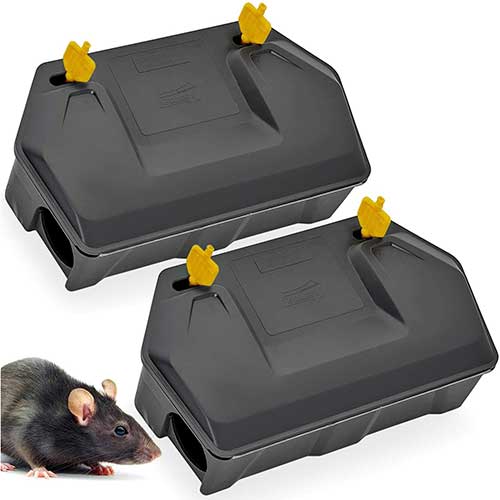
Buy from Amazon
There are no toxic bait products registered for chipmunk control. As chipmunks are in the rodent family, rodenticides that kill mice and rats will work on chipmunks but think twice before using them.
It's one thing to use rodenticides to kill rodents in your home. You can be sure the bait is placed in areas where it won't be reached by pets and children and it's less likely for poisoned rodents to leave your home and for the poison to enter the food chain.
This isn't true with chipmunks.
Applying rodenticide to kill chipmunks outside can be dangerous and put all types of wildlife at risk in addition to children and pets. Many animals eat chipmunks and can be killed or hurt by the poison in the chipmunk's body. This includes snakes, bobcats, raccoons, coyotes, foxes, hawks, owls, and possums. Many of these animals are beneficial to have around your home. Possums, for example, are almost immune to rabies and help eradicate ticks.
How will you be sure the poison is only consumed by chipmunks if applied in your flower beds or yard? Even if it is only consumed by chipmunks as you intend, you will need to be very careful to dispose of the chipmunk bodies or the carcass will attract new pests like rats and flies.
If you do decide to use poison bait, play it safe, and use tamper-proof bait stations to protect pets and children. You won't find poison bait stations for chipmunks; you'll need to use stations designed for rats that have large enough openings for chipmunks. Redtop bait stations are a good choice and they can be paired with rodenticide bait blocks flavored with peanut butter to attract chipmunks.
Getting Rid of Chipmunks with Mothballs
You may see advice about using mothballs to repel chipmunks from your garden but it's not effective and comes with some risks.
Mothballs are made from nearly 100% active ingredient like paradichlorobenzene or naphthalene and they transform from a solid to a toxic vapor over time. The odor of mothballs that you are smelling is actually insecticide.
Mothballs can kill all types of wildlife that you aren't trying to target and pose a risk to your pets. They can also be mistakenly eaten by children if left outside. In 2010, the National Pesticide Information Center reported about 700 inquiries about mothballs involving toxic exposure. About 200 cases involved children.
Exposure to the chemicals in mothballs can cause neurological disorders, liver damage, cataracts, and anemia in humans, especially children.
Trapping and Relocating Chipmunks
Live trapping chipmunks make sense if they're burrowing in a problematic area. Maybe you want to get them out from under your porch so you can set up an exclusion method or you need to banish them from your garden. In cases like this, you can live trap the chipmunks and release them once you've sealed the burrow and set up solutions to repel them.
If you do live trap chipmunks, use a small humane trap that makes it easy to relocate them later.
However, don't expect to have success trapping and relocating all of the chipmunks on your property. Live trapping animals should only be used to get them out of a specific area, not prevent them from returning to your property. Without addressing the reasons the chipmunks are there in the first place, more chipmunks are bound to return.
Relocating wildlife to an unfamiliar area can also be cruel. Animals that are relocated to an unfamiliar area are likely to struggle to survive because they will not know where to find food or safety and they will face threats from native animals.
You will also need to verify that it's legal in your state to trap and relocate wildlife. In many states, some animals can be relocated including squirrels and chipmunks but other animals cannot be removed live from the property such as raccoons.
Related Article: 12 Best Ways To Get Rid of Raccoons

My name is Christine and I'm living in Southwest Ohio where I was born and raised after a decade spent living in Southern California.
While I loved working as a Pest Control Technician in Western Ohio, I did not enjoy the hours.
I decided to find a new career and now I work as a writer and help others find solutions to their pest problems online.
In my free time, I enjoy traveling and going to as many metal concerts as possible.
How Do I Make Raised Garden Beds To Keep Voles Out
Source: https://www.pestcontrolgurus.com/how-to-get-rid-of-chipmunks/
Posted by: pragertharsen.blogspot.com

0 Response to "How Do I Make Raised Garden Beds To Keep Voles Out"
Post a Comment